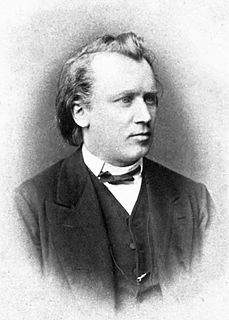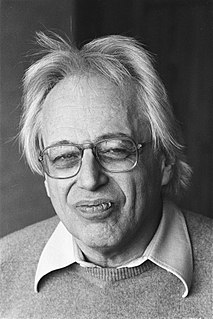Related Research Articles

The Piano Quintet in E-flat major, Op. 44, by Robert Schumann was composed in 1842 and received its first public performance the following year. Noted for its "extroverted, exuberant" character, Schumann's piano quintet is considered one of his finest compositions and a major work of nineteenth-century chamber music. Composed for piano and string quartet, the work revolutionized the instrumentation and musical character of the piano quintet and established it as a quintessentially Romantic genre.
The Piano Quintet in F minor, Op. 34, by Johannes Brahms was completed during the summer of 1864 and published in 1865. It was dedicated to Her Royal Highness Princess Anna of Hesse. Like most piano quintets composed after Robert Schumann's Piano Quintet (1842), it is written for piano and string quartet.
George Rochberg was an American composer of contemporary classical music. Long a serial composer, Rochberg abandoned the practice following the death of his teenage son in 1964; he claimed this compositional technique had proved inadequate to express his grief and had found it empty of expressive intent. By the 1970s, Rochberg's use of tonal passages in his music had invoked controversy among critics and fellow composers. A teacher at the University of Pennsylvania until 1983, Rochberg also served as chairman of its music department until 1968 and was named the first Annenberg Professor of the Humanities in 1978. For notable students See: List of music students by teacher: R to S#George Rochberg.
Sir Lennox Randal Francis Berkeley was an English composer.

The Symphony No. 1 in C minor, Op. 68, is a symphony written by Johannes Brahms. Brahms spent at least fourteen years completing this work, whose sketches date from 1854. Brahms himself declared that the symphony, from sketches to finishing touches, took 21 years, from 1855 to 1876. The premiere of this symphony, conducted by the composer's friend Felix Otto Dessoff, occurred on 4 November 1876, in Karlsruhe, then in the Grand Duchy of Baden. A typical performance lasts between 45 and 50 minutes.

The Octet in F major, D. 803 was composed by Franz Schubert in March 1824. It was commissioned by the renowned clarinetist Ferdinand Troyer and came from the same period as two of Schubert's other major chamber works, the 'Rosamunde' and 'Death and the Maiden' string quartets.
Nigel Keay is a New Zealand composer. He has been a freelance musician since 1983 working as a composer, violist, and violin teacher. Nigel Keay has held the following composer residencies: Mozart Fellowship, University of Otago 1986 and 1987, Nelson School of Music 1988 and 89, Auckland Philharmonia Orchestra 1995.
Antonín Dvořák's Piano Quintet No. 2 in A major, Op. 81, B. 155, is a quintet for piano, 2 violins, viola, and cello. It was composed between August 18 and October 8, 1887, and was premiered in Prague on January 6, 1888. The quintet is acknowledged as one of the masterpieces in the form, along with those of Schumann, Brahms and Shostakovich.
The Horn Trio in E♭ major, Op. 40, by Johannes Brahms is a chamber piece in four movements written for natural horn, violin, and piano. Composed in 1865, the work commemorates the death of Brahms's mother, Christiane, earlier that year. However, it draws on a theme which Brahms had composed twelve years previously but did not publish at the time.

The Trio for Violin, Horn and Piano by György Ligeti was completed in 1982. The piece was a turning point in Ligeti’s career. Ligeti had composed little since he completed his opera, Le Grand Macabre, in 1977, having only finished a few smaller pieces, like Hungarian Rock (chaconne) and Passacaglia ungherese for harpsichord. Influenced by sources as diverse as sub-Saharan African drumming, the music of Conlon Nancarrow, and the piano music of Chopin and Schumann, the Trio is considered to be the watershed moment that opened up his "third way," a style that Ligeti claimed to be neither modern nor postmodern.
The Melos Ensemble is a group of musicians who started in 1950 in London to play chamber music in mixed instrumentation of string instruments, wind instruments and others. The ensemble's reputation for excellence has encouraged composers to write music exploring these resources. Benjamin Britten composed the chamber music for his War Requiem for the Melos Ensemble and conducted the group in the first performance in Coventry.

The Piano Trio No. 1 in B major, Op. 8, by Johannes Brahms was completed in January 1854, when the composer was only twenty years old, published in November 1854 and premiered on 13 October 1855 in Danzig. It has often been mistakenly claimed that the first performance had taken place in the United States. Brahms produced a revised version of the work in summer 1889 that shows significant alterations so that it may even be regarded as a distinct (fourth) piano trio. This “New Edition”, as he called it, was premiered on 10 January 1890 in Budapest and published in February 1891.

The Piano Trio No. 2 in C major, Op. 87, by Johannes Brahms was composed between 1880 and 1882. It is scored for piano, violin and cello.

The Piano Quartet No. 3 in C minor, Op. 60, completed by Johannes Brahms in 1875, is scored for piano, violin, viola and cello. It is sometimes called the Werther Quartet after Goethe's The Sorrows of Young Werther.

The Piano Quartet No. 1 in G minor, Op. 25, was composed by Johannes Brahms between 1856 and 1861. It was premiered in 1861 in Hamburg, with Clara Schumann at the piano. It was also played in Vienna on 16 November 1862, with Brahms himself at the piano supported by members of the Hellmesberger Quartet. Like most piano quartets, it is scored for piano, violin, viola and cello.
Gary Kulesha is a Canadian composer, pianist, conductor, and educator. Since 1995, he has been Composer Advisor to the Toronto Symphony Orchestra. He has been Composer-in-Residence with the Kitchener-Waterloo Symphony (1988–1992) and the Canadian Opera Company (1993–1995). He was awarded the National Arts Centre Orchestra Composer Award in 2002. He currently teaches on the music faculty at the University of Toronto.
Mark Wessel was an American pianist and composer.
Colin Robert Horsley was a New Zealand classical pianist and teacher who was based in the United Kingdom all his working life. He had a significant artistic association with the composer Sir Lennox Berkeley.
The Septet for clarinet, bassoon, horn, piano, violin, viola and cello is a Chamber music composition by Igor Stravinsky. It was composed between July 1952 and February 1953, and the first performance took place at Dumbarton Oaks in Washington, D.C., on 23 January 1954. The score is dedicated to the Dumbarton Oaks Research Library and Collection. It consists of three movements, the first lacking a title, and the last lacking a number in the score. The work is influenced by twelve-tone technique, especially by the Wind Quintet, Op. 26, and the Suite for septet, Op. 29, composed by Arnold Schoenberg.
The Trio for horn, violin, and piano is a chamber-music work by the Australian composer Don Banks. It was composed in 1962 and premiered the same year at the Edinburgh Festival. A performance takes about 15 minutes.
References
- Anon. n.d. "Lennox Berkeley: Trio for Horn, Violin, and Piano (1953)". Music Sales Classical website (accessed 28 December 2014).
- Anon. 1954. "Lennox Berkeley's New Work: A Horn Trio". The Times, issue 52893 (30 March): 3.
- Craggs, Stewart R. 2000. Lennox Berkeley: A Source Book. Aldershot, Hants.: Ashgate Publishers. ISBN 9780859679336.
- Dickinson, Peter. 2001. "Berkeley, Sir Lennox (Randall Francis)". The New Grove Dictionary of Music and Musicians, second edition, edited by Stanley Sadie and John Tyrrell. London: Macmillan Publishers.
- Dickinson, Peter. 2003. The Music of Lennox Berkeley, second, revised edition. Woodbridge, Suffolk, and Rochester, NY: The Boydell Press. ISBN 0-85115-936-2.
- Gamble, Stephen, and William C. Lynch. 2011. Dennis Brain: A Life in Music. North Texas Lives of Musicians Series 7. Denton: University of North Texas Press. ISBN 978-1-57441-307-6.
- Lamoreaux, Andrea. 1989. "Berkeley, Lennox (1903-1989): Trio for Violin, Horn and Piano, Op. 44". Chicago Chamber Musicians website (accessed 28 December 2014).
- Żuk, Zbigniew. 1997. "Dedicated to the Brilliant Horn-Soloist Barry Tuckwell". Liner notes to Horn Trios. Zbigniew Żuk, horn; Jan Stanienda, violin; Piotr Folkert, piano. Recorded 18–20 March 1997 in Bydgoszcz Philharmonia Hall. CD recording, 1 disc: 12 cm, digital, stereo. Żuk Records CD 310. Bremerhaven: Żuk Records.